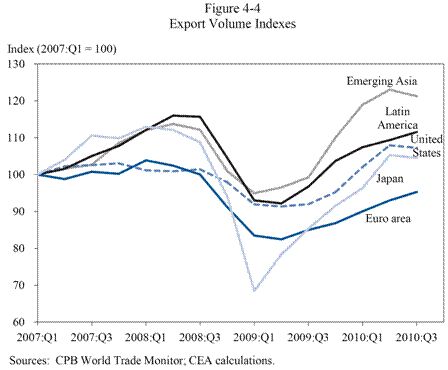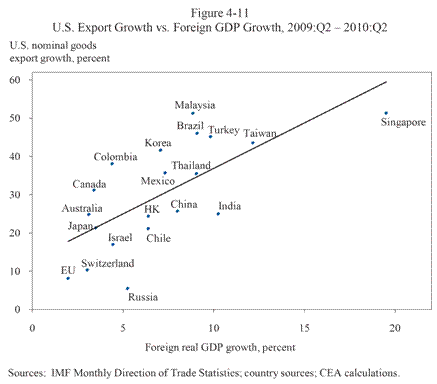The Economic Report of the President, 2011 is out. The topical chapters are:
- Chapter 1: From Crisis to Recovery and Growth
- Chapter 2: The Year in Review and the Years Ahead
- Chapter 3: The Foundations of Growth
- Chapter 4: The World Economy
- Chapter 5: Health Care Reform
- Chapter 6: Transitioning to a Clean Energy Future
- Chapter 7: Supporting America’s Small Businesses
From the chapter on the world economy:

Source: Economic Report of the President, 2011
There is a thoughtful discussion of the goal of doubling exports (discussed earlier in this post, as well as this one); one interesting graph is here.

Source: Economic Report of the President, 2011
The purpose of focusing on export growth is misdirection. The issue is what happens to the trade balance, and that has resumed its pattern of unustainable deficits. The deficits have the same effect on AD as contractionary fiscal policy.
Looking at just one side of the trade balance is a common trick to divert attention away from ‘protectionist’ pressures. Except that now, measures to discourage currency mercantilism abroad are not ‘protectionism,’ but actually movements towards the free-trade equilibrium.
About the only chance the U.S. has for strong export growth is from agricultural exports, which may give us a classic case of Dutch disease, as we accept imported manufactures for exports of food. And the effect on labor demand would be adverse, since Ag exports require little labor.
“There is a thoughtful discussion of the goal of doubling exports”
I think the most ‘thoughtful’ response would result in ridiculing the idea.
OT:
Goulash Populism
Uncle George writes an op-ed for the WSJ on Hungary’s misguided macro policies.
http://online.wsj.com/article/SB10001424052748703408604576163673734092138.htm
don …the effect on labor demand would be adverse, since Ag exports require little labor.
I’m not sure that’s right. There’s more to growing corn and soybeans than the farmer’s direct labor input; you also need capital inputs and production of those capital inputs requires labor from the manufacturing sector. For example, John Deere just announced a doubling of net income and is expecting a 50% increase in demand for tractors. John Deere exports of farm equipment to South America are booming because of high food prices. And don’t forget that someone has to dry the grain after its harvested, build storage bins and transport it to markets.
2slugbaits:
Virtually any output has manufactured and constructed inputs, even medical services, but U.S. Ag output uses little labor per dollar of final demand compared with other traded goods industries. Further, I expect much, if not the bulk, of the increase in Ag exports to come from increased value rather than increased quantity, that is to say, as a result of price increases. Finally, I would not be surprised to see manufactured inputs to farm production move offshore, such as has happened (and is still happening) with lawnmowers, power tools, and consumer durables. In fact, I wonder about the U.S. content of Deere’s production.
An interesting correlation, although it makes sense that economic growth would be accompanied by an overall increase in imports (from not only the US, but also other countries around the world). I clicked through the other links and read the analysis of exports/growth in the rest of the world.
Don,
Interestingly enough most heavy duty manufacturers tend to use local content at higher rates than the automotive industry. There are two competing issues at play and that is the cost of WIP with its long logistics tail plus ever increasing energy costs and the lower volume of production is less attractive to offshore.